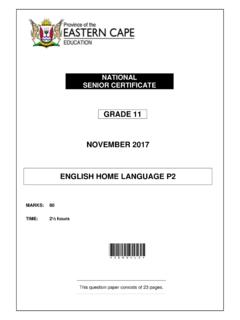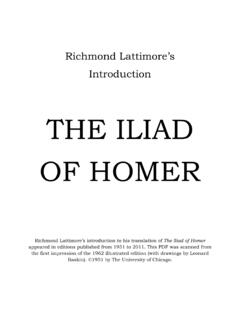Transcription of th11 -12th Grade English Language Arts Georgia Standards ...
1 11th -12th Grade English Language Arts Georgia Standards of Excellence (ELA GSE) Georgia Department of Education April 15, 2015 Page 1 of 5 READING LITERARY (RL) READING INFORMATIONAL (RI) Key Ideas and Details Key Ideas and Details ELAGSE11-12RL1: Cite strong and thorough textual evidence to support analysis of what the text says expli cit ly as well as inferences drawn from the text, including determining where the text leaves matters uncertain. ELAGSE11-12RI1: Cite strong and thorough textual evidence to support analysis of what the text says expli cit ly as well as inferences drawn from the text, including determining where the text leaves matters uncertain. ELAGSE11-12RL2: Determine two or more themes or central ideas of text and analyze their development over the course of the text, including how they interact and build on one another to produce a complex account; provide an objective summary of the text. ELAGSE11-12RI2: Determine two or more central ideas of a text and analyze their development over the course of the text, including how they interact and build on one another to provi de a complex analysis; provide an objective summary of the text.
2 ELAGSE11-12RL3: Analyze the impact of the author s choices regarding how to develop and relate elements of a story or drama ( , where a story is set, how the action is ordered, how the characters are introduced and developed). ELAGSE11-12RI3: Analyze a complex set of ideas or sequence of events and explain how specific individuals, i deas, or events interact and develop over the course of the text. Craft and Structure Craft and Structure ELAGSE11-12RL4: Determine the meaning of words and phrases as they are used in the text, including figurative and connotative meanings; analyze the impact of specific word choices on meaning and tone, including words with mult iple meanings or Language that is particularly fresh, engaging, or beautiful. (Include Shakespeare as well as other authors.) ELAGSE11-12RI4: Determine the meaning of words and phrases as they are used in a text, including figurative, connotative, and technical meanings; analyze how an author uses and refines the meaning of a key term or terms over the course of a text ( , how Madison defines faction in Federalist No.)
3 10). ELAGSE11-12RL5: Analyze how an author s choices concerning how to structure specific parts of a text ( , the choice of where to begin or end a story, the choice to provi de a comedic or tragic resolution) contribute to its overall structure and meaning as well as its aesthetic impact. ELAGSE11-12RI5: Analyze and evaluate the effectiveness of the structure an author uses in his or her exposit ion or argument, including whether the structure makes points clear, convi ncing, and engaging. ELAGSE11-12RL6: Analyze a case in which grasping point of view requires distinguishing what is dir ectly stated in a text from what is really meant ( , satire, sarcasm, irony, or understatement). ELAGSE11-12RI6: Determine an author s point of view or purpose in a text in which the rhetoric is particularly effective, analyzing how style and content contribute to the power, persuasiveness, or beauty of the text. Integration of Knowledge and Ideas Integration of Knowledge and Ideas ELAGSE11-12RL7: Analyze multiple interpretations of a story, drama, or poem ( , recorded or live production of a play or recorded novel or poetry ), evaluating how each version interprets the source text.
4 (Include at least one play by Shakespeare as well as one play by an American ELAGSE11-12RI7: Integrate and evaluate multiple sources of information presented indifferent media or formats ( , vi sually, quantitatively) as well as in words in order to address a question or solve a problem. ELAGSE11-12RL8: (Not applicable to literature) ELAGSE11-12RI8: Delineate and evaluate the reasoning in seminal texts, including the application of constitutional principles and use of legal reasoning ( , in Supreme Court majority opinions and dissents) and the premises, purposes, and arguments in works of public advocacy ( , The Federalist, presidential addresses.) ELAGSE11-12RL9: Demonstrate knowledge of eighteenth-, nineteenth- and early twentieth-century foundational works (of American Literature, British Literature, World Literature, or Multicultural Literature), including how two or more texts from the same period treat similar themes or topics. ELAGSE11-12RI9: Analyze foundational documents of historical and literary significance (including The Decla ration of Independence, the Preamble to the Constitution, the Bil l of Rights, and Lin coln s Second Inaugural Address) for their themes , purposes, and rhetorical features.)
5 For Britis h Literature, American Lit era ture, and Multicultural Lit era ture use comparable documents of historical significance. Range of Reading and Level of Text Complexity Range of Reading and Level of Text Complexity ELAGSE11-12RL10: By the end of Grade 11, read and comprehend literature, including stories, dramas, and poems, in the grades 11-CCR text complexity band proficiently, with scaffolding as needed at the high end of the range. By the end of Grade 12, read and comprehend literature, including stories, dramas, and poems, in the grades 11- CCR text complexity band independently and proficiently. ELAGSE11-12RI10: By the end of Grade 11, read and comprehend literary nonfiction in the grades 11-CCR text complexity band proficiently, with scaffolding as needed at the high end of the range. By the end of Grade 12, read and comprehend literary nonfiction in the grades 11-CCR text complexity band independently and proficiently. 11th -12th Grade English Language Arts Georgia Standards of Excellence (ELA GSE) Georgia Department of Education April 15, 2015 Page 2 of 5 Text Types and Purposes WRITING (W) ELAGSE11-12W1: Writ e arguments to support claims in an analysis of substantive topic s or text s, using vali d re asoning and relevant and sufficient evidence.
6 A. Introduce precise, knowledgeable claim(s), establish the significance of the claim(s), distinguish the claim(s) fro m alternate or opposing claims, and create an organization that logic all y sequences claim(s), counterclaims, re asons, and evidence. b. Develop claim(s) and counterclaims fairl y and thoroughly , supplyi ng the most relevant evidence fo r each while pointing out the stre ngths and li mitations of both in a manner that antic ipates the audience s knowledge level, concer ns, values, and possible biases. c. Use words, phrases, and clauses as well as varied syntax to li nk the major sections of the text , cre ate cohesio n, and clarif y the relatio nships bet ween claim(s) and re asons, between re asons and evidence, and between claim(s) and counterclaims. d. Establish and maintain a formal style and objectiv e tone while attending to the norms and conventions of the discipline in whic h they are writ ing. e. Provide a concluding statement or section that follows from and supports the argument presented.
7 ELAGSE11-12W2: Writ e informative/explanatory text s to examine and convey complex ideas, concepts, and information clearly and accurately through the effectiv e selection, organizati on, and analysis of content. a. Introduce a topic ; organize complex ideas, concepts, and information so that each new ele ment builds on that which precedes it to create a unified whole; include formatting ( , headings), graphic s ( , figure s, tables), and multi media when useful to aiding compre hension. b. Develop the to pic thoroughly by selecting the most significant and re levant facts, ext ended definitio ns, concret e detail s, quotatio ns, or other information and examples appropriate to the audience s knowledge of the topic . c. Use appropri ate and varied transit ions and syntax to li nk the major sections of the text , create cohesion, and clarif y the relationships among complex ideas and concepts. d. Use precise Language , domain-specific vocabulary , and techniques such as met aphor, simile, and analogy to manage the complexity of the topic.
8 E. Establish and maintain a formal style and objectiv e tone while attending to the norms and conventions of the discipline in whic h they are writ ing. f. Provide a concluding state ment or section that follows from and supports the information or explanation pre sented ( , articulating implic ations or the significance of the topic). ELAGSE11-12W3: Write narratives to develop real or imagined experiences or events using effective technique, well-chosen details, and well-structured event sequences. a. Engage and orient the re ader by setting out a problem, situation, or observation and it s significance, establishing one or multi ple point(s) of view, and introducing a narr ator and/or characters; create a smooth progre ssion of experiences or events. b. Use narr ative techniques, such as dialo gue, pacing, descriptio n, reflection, and multi ple plot li nes, to develop experiences, events, and/or characters. c. Use a variety of techniques to sequence events so that they build on one another to create a cohere nt whole and build toward a particular tone and outcome ( , a sense of mystery, suspense, gro wth, or re solution).
9 D. Use precise words and phrases, telling detail s, and sensory Language to convey a vivid picture of the experiences, events, set ting, and/or characters. e. Provide a conclusion that follows from and reflects on what is experienced, observed, or resolved over the course of the narr ative. Production and Distribution of Writi ng ELAGSE11-12W4: Produce clear and coherent writing in whic h the develo pment, organization, and style are appropriate to task, purpose, and audience. ( Grade -specific expectations for writing types are defined in Standards 1 3 above.) ELAGSE11-12W5: Develop and strengthen writing as needed by planning, revising, editi ng, re writing, or trying a new approach, focusing on addressing what is most significant fo r a specific purpose and audience. (Editi ng for conventio ns should demonstrate command of Language Standards 1 3 up to and including grades 11-12.) ELAGSE11-12W6: Use technology, including the Internet, to produce, publish, and update individual or share d writi ng products in re sponse to ongoing feedback, including new arguments or information.
10 Research to Build and Present Knowledge ELAGSE11-12W7: Conduct short as well as more sustained re search projects to answer a questio n (including a self-gener ated questio n) or solve a problem; narrow or broaden the inquiry when appropriate ; synthesiz e multi ple sources on the subject, demonstrating understanding of the subje ct under investigation. ELAGSE11-12W8: Gather relevant information from multi ple authoritative print and digital sources, using advanced searches effectively ; assess the str engths and li mit ations of each sourc e in terms of the task, purpose, and audience; integrate information into the text selectively to maintain the flow of ideas, avoiding plagiarism and overreliance on any one sourc e and following a standard format for cit ation. ELAGSE11-12W9: Draw evidence from literary or informational te xt s to support analysis, reflection, and re searc h. a. Apply grades 11 12 Reading standard s to literature ( , Demonstrate knowledge of ei ghteenth-, nineteenth- and early-twentieth-century foundational works of American literature , including how two or more text s from the same period treat simil ar themes or topic s ).














